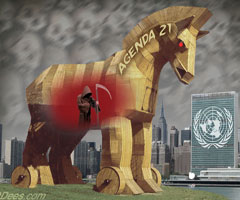 |
| Dees Illustration |
Debbie Coffey
The PPJ Gazette
People have noticed the 25 government agencies on Obama’s new White House Rural Council. And, they’re questioning what might be the need for all of them.
What people may not have noticed yet, is that the government agencies in this council are also on other councils. These councils, as well as the individual government agencies, are implementing international laws that have taken effect through Executive Orders, Memorandums of Understanding, agreements and regulations that most Americans don’t even know about. These have bypassed Congress. And, it also seems they have completely bypassed the Constitution.
The devil is in the details
These agencies and councils are forming “partnerships” with members and groups other than the American people. However, our tax dollars pay for their salaries and for the programs.
Some “partnerships” sound innocuous, but as you might guess, the devil is in the details.
I’ll give you an example. There is a BioEco Working Group ( www.bioeco.gov), which at first glance seems to be part of the Department of Interior’s U.S.Geological Survey, since it is listed as creating the website. But the actual Charter has National Science and Technology Council in the heading. (The National Science and Technology Council includes 20 of the same agencies that are on the new Rural Council, but with some additional agencies, including the CIA. It also includes the Vice-President, Cabinet Secretaries, heads of Agencies and some White House officials.)
Participating agencies in the BioEco Working Group are the Depts. of Agriculture, Defense, Energy, State, EPA, NASA, U.S. Fish and Wildlife Service (Dept. of the Interior), U.S. Geological Survey (Dept. of the Interior), Department of Health and Human Services, National Institutes of Health, National Oceanographic and Atmospheric Administration, National Science Foundation, and the Smithsonian Institution. It seems BioEco also wanted to solicit the membership of the National Archives and Records Administration and U.S. AID.
In the Appendix of the Charter, signed in 2008 by Ann Bartuska of the U.S. Forest Service (under the U.S. Dept. of Agriculture) and Susan Haseltine of the U.S. Geological Survey (under the U.S. Dept. of the Interior), it states activities of this work group are to:
Provide a focal point for coordinating U.S. biodiversity and ecosystem informatics activities with international efforts and organizations in this and related areas (such as the Global Biodiversity Information Facility (GBIF), the Global Earth Observation System of Systems (GEOSS), the Consortium for the Barcode of Life (CBOL), and the Encyclopedia of Life (EoL), to ensure compatability of standards and approaches, facilitate sharing of technologies, and provide for equity/reciprocity in data access and exchange.
You might think, “this is nice, we’re sharing information with everybody.” Then you might notice that these organizations seem to map land and catalog biological resources.
On the website of the Global Biodiversity Information Facility (GBIF), which is an international organization with “many partners,” the GBIF’s Memorandum of Understanding (with its participants), Paragraph 3, states Objectives:
Purpose
The purpose of GBIF is to promote, co-ordinate, design and implement the compilation, linking, standardisation, digitisation and global dissemination of the world’s biodiversity data, within an appropriate framework for property rights and due attribution.
Co-operation and Co-ordination
The Participants intend to encourage co-operation amongst themselves in the implementation of GBIF and in the development of joint work programmes in areas of mutual interest with the Secretariat of the Convention on Biological Diversity and other appropriate bodies and initiatives…
Wait a sec, our U.S. Senate didn’t ratify the treaty for the Convention of Biological Diversity (which means the U.S. Senate didn’t formally approve of or vote for the U.S. to be part of the Convention on Biological Diversity). So now all of these U.S. agencies are encouraging each other to develop “programmes” that the Secretariat of the Convention on Biological Diversity is interested in? Wouldn’t that be…the Convention on Biological Diversity?
If the same U.S. agencies that have agreed to encourage each other are on the new White House Rural Council, are these agencies going to encourage each other to develop and implement the Convention on Biological Diversity in the Rural Council meetings, too?
The Convention on Biological Diversity (CBD)
This is an internationally binding treaty and was presented for signature at the Earth Summit at Rio de Janeiro in 1992. Sounds like the treaty should be about biological diversity, doesn’t it?
If you read the text of the treaty, you’ll find out that if there’s a “dispute” that isn’t resolved between two parties, the State or organization has to settle it in the International Court of Justice, or in a three person arbitral tribunal, where each party gets one arbitrator and the third arbitrator, the President of the Tribunal, is to be from an entirely different nation.
The CBD website states that this treaty was “Conceived as a practical tool for translating the principles of Agenda 21 into reality.”
The United Nations’ Agenda 21
If you look at the United Nation’s Agenda 21 (Section 1, 7.28 and 7.29), you see why the BioEco Working Group might be mapping land and creating an inventory of biological resources:
All countries should consider, as appropriate, undertaking a comprehensive national inventory of their land resources in order to establish a land information system in which land resources will be classified according to their most appropriate uses and environmentally fragile or disaster-prone areas will be identified for special protection measures.
(Who will decide the most “appropriate” use of our land? The United Nations?)
More importantly, above this description is the OBJECTIVE, which is “the encouragement of communally and collectively owned and managed land.”
Cassandra Anderson of www.morphcity.com pointed out that collectivism is a “Political philosophy where a small group determines the “greater good” for the masses. While it could take the form of communism, fascism, socialism, etc, the common denominator is control over the population.”
Although the White House Rural Council might seem to be about helping our rural communities, it’s more likely going to be about letting international interests help themselves to our rural communities.
AUTHOR’S NOTE: The Bureau of Land Management is removing our wild horses from their federally protected Herd Management Areas, then leasing the same land for $2 an acre for oil and gas lease sales, or permitting new mining and mining expansions to foreign owned companies. I think the wild horses are like the canary in the coal mine. As go these American icons that stand as symbols of our freedom, so goes our freedom.
TO LEARN MORE:
www.morphcity.com for excellent articles by Cassandra Anderson
and excellent articles by Marti Oakley:
http://ppjg.wordpress.com/2011/07/14/executive-order-13575-the-theft-of-rural-and-agricultural-lands-for-un-agenda-21/#more-17083
http://ppjg.wordpress.com/2011/06/19/just-another-brick-in-the-wall-un-agenda-21-in-us-law/#more-16780
SOURCES:
http://www.bioeco.gov/binary_docs/Charter-BioEco%20Approved%20May%202008.pdf
http://www.gbif.org/governance/governing-board/
http://www.gbif.org/governance/partnerships/
http://www.gbif.org/governance/governing-board/voting-participants/
http://www.whitehouse.gov/administration/eop/ostp/nstc/about/members
http://www.whitehouse.gov/administration/eop/ostp/nstc/about
http://www.cbd.int/secretariat/role.shtml
http://www.cbd.int/secretariat/structure/
http://www.cbd.int/convention/text/
http://www.un.org/esa/dsd/agenda21/res_agenda21_07.shtml
http://www.un.org/esa/dsd/agenda21/res_agenda21_00.shtml
http://www.cbd.int/convention/
The new White House Rural Council includes: the Departments of Agriculture, Treasury, Defense, Justice, Interior, Commerce, Labor, Health and Human Services, Housing and Urban Development, Transportation, Energy, Education, Veterans Affairs, Homeland Security, Environmental Protection Agency, Federal Communications Commission, the Offices of Management and Budget, Science and Technology Policy, National Drug Control Policy, White House Office of Public Engagement and Intergovernmental Affairs, Office of Public Affairs, and other Councils, including Council of Economic Advisors, the Domestic Policy Council, National Economic Council, Small Business Administration, Council on Environmental Quality.
linkwithin_text=’Related Articles:’



Be the first to comment on "The Quiet Coup: The Implementation of Agenda 21"